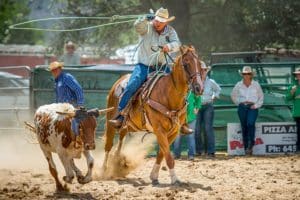Trim Excess Pounds From Your Equine Athlete

Weight-Loss Cornerstones
A safe diet strategy promotes weight loss without triggering metabolic, gastrointestinal, or behavioral problems. Using Henneke’s equine body condition scoring (BCS, a scale of 1-9), the goal is to reduce the horse’s body condition score by no more than one per month. An ideal score for most of our equine athletes is a 4 or 5—moderately thin to moderate, Shepherd said. Depending on the size and type of horse, a single score change could equate to a 25-50-pound weight loss over 30 days.
The key to healthy weight loss is a forage-based ration, explained Shepherd. Eliminating energy-dense grains and textured feeds is a simple way to cut excess calories and sugars (such as molasses) that overweight horses don’t need. A good-quality hay can provide enough fiber to satisfy hunger while also meeting an overweight performance horse’s energy requirements. Shepherd also recommends complementing the forage with highly fortified “balancer pellets.” These generally contain 30% crude protein and supply essential vitamins and minerals. Two key nutrients that must be met by either balancer pellets or a granular vitamin-mineral supplement are vitamin E, for horses without access to pasture, and selenium, for horses in deficient areas. The supplement or pellets should also include copper and zinc, which might be partially met by forage. Provide free access to salt near a fresh water source, as well.
Reaching a Target Weight
Using a weight tape, begin by recording the horse’s current weight and body condition score. Then determine his “target weight,” based on size, breed, and desired BCS. Shepherd said apps have been developed to help owners formulate breed- and performance-specific nutrition plans. She also suggests that the same person remain in charge of the weight tape, so the horse gets measured the same way each time. Monitor changes every two to four weeks
Create a free account with TheHorse.com to view this content.
TheHorse.com is home to thousands of free articles about horse health care. In order to access some of our exclusive free content, you must be signed into TheHorse.com.
Start your free account today!
Already have an account?
and continue reading.
Related Articles
Stay on top of the most recent Horse Health news with

















